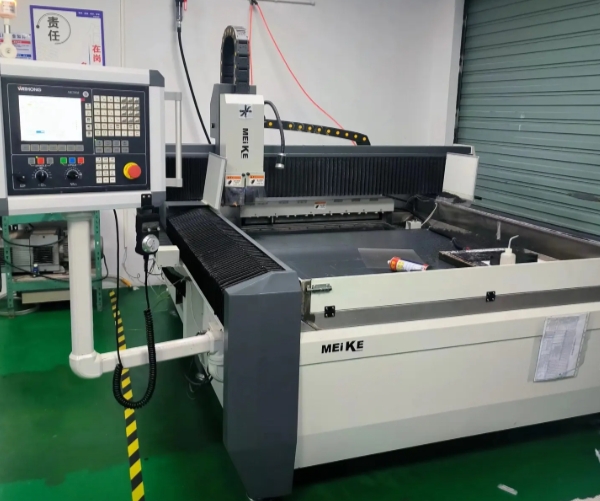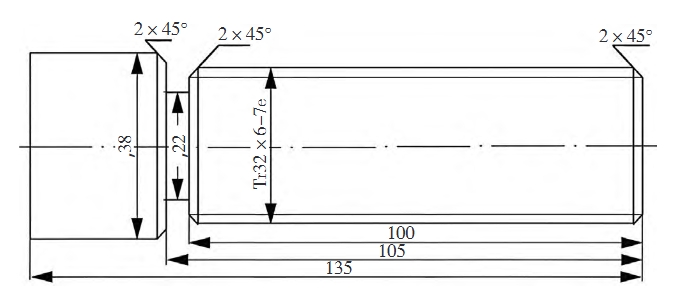As an important part of the mechanical transmission system, high-quality gears play a great role in the smoothness of the transmission.
With the development of the automotive industry, the demand for high-precision gears has put forward higher requirements for gear machining process.
So, what are the factors that affect the accuracy of gear machining? How to control the machining accuracy?

Gear
Factors affecting gear machining accuracy
The gear is the core transmission component in automobile movement. Its processing quality directly impacts automobile assembly, the vehicle’s reliability, and can even limit the overall improvement of the automobile.
Many factors affect the precision of automotive gear machining. These include tool quality, fixtures, machine accuracy, machine tool adjustments, cutting force, and temperature control during machining.
Analyzing the factors affecting gear machining accuracy is the key to improving the quality of gear machining.
1. Tool quality
In the processing of automotive gears, the choice of tool directly affects the precision and efficiency of processing. Automotive gear processing tools are mainly gear cutter, hobbing knife, molding knife and so on.
Tool wear and deformation of its cutting edge can cause several issues. The tip of the tool may develop scratches or fatigue cracks, which can lead to increased surface roughness.
As a result, cutting force and cutting temperature also increase, potentially causing defects such as burns.
These issues ultimately lead to deviations in the surface shape, affecting the mechanical properties of the parts and reducing their service life.
In the actual processing, cutting parameters should be reasonably selected according to the technical requirements, and the correct processing program should be formulated to ensure the processing quality of gears.
2. Workholding fixture
The fixture has an important influence on the machining accuracy of automotive gears.
To ensure the accurate positioning of the workpiece in the fixture, it must not move or vibrate during processing.
The rigidity of the fixture, clamping strength, and position are crucial factors affecting the machining accuracy of automotive gears.
Additionally, the contact area between the fixture and tool also plays a significant role in the accuracy of the machining process.
In actual production, radial and axial runouts of the gear fixture must be controlled within 0.02mm. This ensures the workpiece is accurately positioned for high-quality machining.
3. The precision of the processing machine and machine tool adjustment
As advanced manufacturing technology develops, demand for high-quality, high-precision gears has grown rapidly. Traditional gear processing equipment can no longer meet the required machining accuracy.
At this time, it is vital to improve the gear processing equipment to improve its processing accuracy and stability.
The use of simulation technology can help comprehensively analyze potential problems before the processing process.
This allows for early detection of issues that may arise. Using hard materials cutting tools can improve gear machining accuracy.
The introduction of automatic load unloading systems, automatic tool loading and unloading systems, and automatic slag removal devices can enhance the stability of operation.
These improvements help achieve optimal control.
4. Cutting force and temperature control during machining
The interaction force of the tool workpiece during cutting interacts with each other under the action of the external force, which generates errors.
The friction of the tool cutting workpiece generates heat, and too much heat will lead to a reduction in machining accuracy, so it is necessary to keep the machine tool at a constant temperature of 20~25℃.
Control of the appropriate rotational speed of the cutter, cutting force and the margin of rough cutting can reduce the impact of temperature on machining accuracy.

Automotive gear machining process analysis
The processing of automotive gears is divided into three stages: billet machining, tooth face machining, finishing after heat treatment. Generally used processing technology is:
turning blanks → cutting teeth (hobbing / gear insertion) → shaving → carburizing quenching → grinding.
The processing of automotive gears is more complex than that of machine tool gears. Therefore, automotive gears require higher impact toughness, fatigue strength, hardness, and abrasion resistance than machine tool gears.
Selection of carburized steel manufacturing and carburizing heat treatment can meet the performance requirements of processing automotive gears.
Reduce the shape and position tolerance, gear end face, bore and other parts of the fine grinding process can achieve dimensional accuracy.
The final arrangement of honing processing can reduce the surface roughness to Ra 0.05~0.20μm.
Measures to improve gear machining accuracy
1. Improve the quality of cutting tools
High-quality cutting tools are essential for ensuring the machining accuracy of automotive gears. Tools such as molding milling cutters and molding grinding wheels directly impact the shape accuracy of the gears.
Gear hob, spline hob, gear inserting tools and other spreading tools will affect the shape accuracy of the cutting edge shape error;
Drills, reamers, keyway milling cutters and other positioning dimensions of the dimensional accuracy of cutting tools will directly affect the dimensional accuracy of the auto gears.
The dimensional accuracy of positioning tools such as drills, reamers, keyway milling cutters, etc. will directly affect the dimensional accuracy of automotive gears.
Optimization of cutting tools can ensure sharpening accuracy and loading accuracy, and timely demagnetization of cutter discs and cutter bars.
2. Enhance the precision of tooth blank
The precision of the automotive gear blank occupies an important position in the gear processing process.
This is because the benchmark used in the subsequent tooth processing and inspection must be processed at this stage.
The precision of the tooth blank is directly related to the gear installation accuracy and positioning accuracy.
The deviation of the installation gap of the tooth blank will lead to tooth endface runout and radial runout. Eccentricity problems will occur in the processing.
Therefore, the machining allowance and machining accuracy of the gear blank should be strictly controlled.
3. Increase the isothermal normalizing process of gear blanks
The heat treatment of gear blanks impacts the precision of automotive gears. To improve their mechanical properties, automotive gears require a carburizing quenching process.
The processing accuracy of the gear blank is directly related to the positioning accuracy and installation accuracy of the automotive gear.
The size of the installation gap of the gear blank will also affect the qualification rate.
If the deviation is too large, it will lead to excessive gear diameter jump and cause eccentricity issues in gear processing.
Therefore, in automotive gear processing, we must strictly control billet machining accuracy and machining allowance. We can use the billet isothermal normalizing process to improve machining accuracy.
4. Improve the precision of the processing machine
High precision automotive gear processing will reduce the geometric eccentricity and radial error, to prevent radial displacement of the cut gear teeth.
Ensure high manufacturing accuracy can reduce the coaxiality error, so that the gear in the transmission process can be accurately aligned and meshing.
Motion eccentricity and tangential error will also affect the accuracy of transmission.
Improving the processing accuracy of automotive gears can effectively reduce the transmission error of the transmission chain.
It also reduces the deviation of the indexing worm gear and the center of rotation of the worktable, which helps to minimize the tangential error.
5. Adopt hardened gear surface processing technology
With the improvement of automotive gear processing technology, carburized hardened gears significantly enhance the bending strength and contact strength of the gear teeth.
This allows for greater torque transmission within a smaller volume and results in higher load-carrying capacity and longer service life.
Automotive gears with hardness above HRC 40 need to be hardened or carburized to improve finishing quality.
In order to ensure the hardness and strength of gears, it is necessary to apply appropriate surface treatment and heat treatment to the gear materials.
For hardened gear processing, we generally use materials such as hardened gear steel, alloy steel, and other high wear-resistant, high-strength metals.
Automotive gear processing equipment and processing technology have a direct impact on the surface quality of the gear.
To ensure the precision and flatness of the gear tooth surface, precision machining processes like gear grinding, hobbing, and shaping can be used. These processes also improve transmission efficiency and reduce noise.
6. Precision control in the process of automotive gear processing
To control automotive gear machining errors and ensure machining accuracy and excellent performance, we can make several improvements.
These include upgrading the accuracy of cutting tools and machine tools, and optimizing process parameters. Additionally, enhancing workpiece installation precision and implementing technological innovations further improve the process.
Together, these methods help strengthen control measures in gear processing.
> First of all, high-precision cutting tools and machine tools should be selected.
This ensures that key parameters—such as the flatness and straightness of the machine tool guideway and the precision of the spindle—meet the required processing standards.
At the same time, select high-quality, high-precision cutting tools to ensure that the processing shape and sharpness of the tool meets the processing requirements, and regular testing and repair.
> Secondly, it is important to optimize the process parameters.
According to the selection principles, we should reasonably choose cutting speed, feed rate, and depth of cut to ensure the stability of the cutting process.
In addition, the coolant must be used properly to reduce thermal deformation and thermal errors. This helps maintain a stable temperature in the cutting area, further enhancing machining accuracy.
It can also improve the installation accuracy of the workpiece, and choose the fixture with good stability to ensure the accurate positioning of the workpiece and the stability of the machining process.
> Finally, error compensation technology, precision measurement technology
Technologies such as optimizing the machining sequence and improving fixture design can enhance fixture accuracy and stability. This, in turn, improves the installation accuracy of the workpiece.
There are many factors affecting the accuracy of automotive gear processing.
In addition to taking effective process measures, it is essential to ensure correct tool installation, high hob manufacturing precision, and an accurate machining process.
Factors such as tool quality, tooth blank accuracy, and isothermal normalizing of the blank must be strictly controlled. Additionally, the precision of the processing machine tool and the accuracy of tooling fixtures and production links are also critical.
Only by maintaining strict control over the accuracy at each stage can we ensure the quality of automotive gear machining and continuously improve machining accuracy.
Through the above methods, we can effectively improve the machining precision of automobile gears, thereby enhancing the performance and safety of automobiles.
Conclusion
Improving the machining accuracy of automotive gears is essential to ensure reliable vehicle performance and enhance overall transmission efficiency.
As this article highlights, key influencing factors include tool quality, fixture stability, machine precision, temperature control, and tooth blank accuracy.
By adopting high-quality cutting tools and optimizing machining parameters, manufacturers can significantly reduce gear machining errors.
Additionally, implementing advanced heat treatment processes like isothermal normalizing and upgrading processing equipment further enhances control over machining accuracy.
Ultimately, strict quality management across every production stage enables the consistent production of high-precision gears.
This approach meets the growing demands of the automotive industry for higher durability, reduced noise, and enhanced power transmission.



